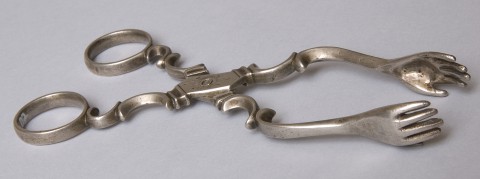Sugar tongs
karta katalogowa kolekcji
Rzemiosło artystyczne
2nd half of 19th century
Cast silver
12.5 x 4.7 cm
Wil.3807
Sugar was not always available in a loose form easily served with a spoon. At least to the middle of the nineteenth century it was obtained from sugar cane and sold in “heads” – conical hard lumps (from one to ten kgs), which had to be divided into larger pieces with a special axe and into smaller ones – by using tongs. The crushed delicacy was segregated, and shapely small chunks were placed in a sugar bowl. Small tongs, known in Polish as szczypczyki or kleszczyki, were added for the convenience of the users. They were produced in two basic forms imitating scissors or the letter U. Each ended with decorated prongs making it easier it lift the lumps of sugar; as a rule, the prongs were in the shape of sharp claws or, more rarely, of a hand or a shovel. Tongs vanished in about the mid-nineteenth century after the introduction of beet sugar, although today they may be used again for sugar cubes.
Joanna Paprocka-Gajek
Polecane

Warsaw cafes two centuries ago
Among invaluable information found in the columns by Gerard Maurycy Witkowski from “Gazeta Warszawska”, we can run across some information …

Jerzy Franciszek Kulczycki – the founder of the first café in Vienna
Jerzy Franciszek Kulczycki (actually Kolczycki or Kólczycki, ca. 1640–1694), a translator of Turkish and dragoman* of Eastern Trade Company, made …

Tea and coffee set
A unique coffee and tea set made of gold plated silver upon the request of Aleksandra Engelhardt, wife of Hetman …

















